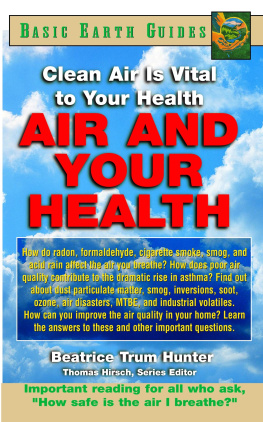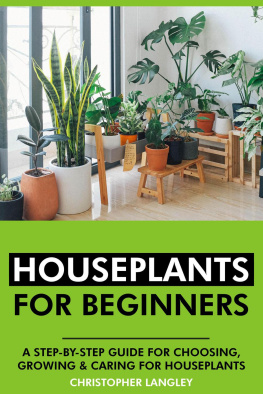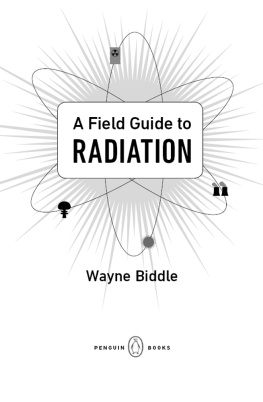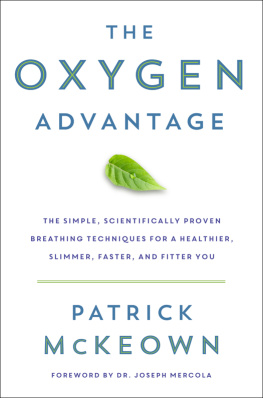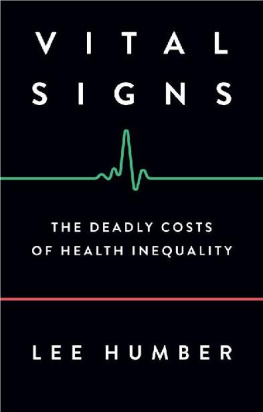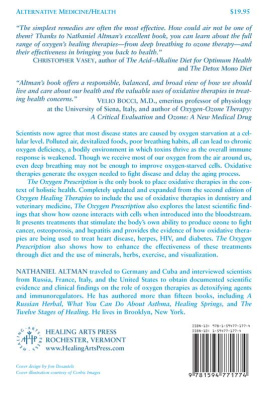EDITORS NOTE
Dear Reader:
Welcome to the Basic Earth Guide series! As you know, the natural world is becoming degraded at an alarming rate. Hardly a day passes without a new headline about the effects of global warming, species loss, and other distressing environmental news. Incredibly, during every second of every day, more than an acre of the worlds precious and irreplaceable rain forests is being lost. The depletion of beneficial oxygen-producing plants, which are part of the rain forests ecosystem, makes us vulnerable to the 6,000 metric tons of carbon dioxide emitted into the atmosphere each year. The subtraction of oxygen, and the addition of carbon dioxide, adversely affect everyones health and quality of life. This example is but one of a number of environmental problems that beset us. Residues of toxic pollutants, ranging from pesticides in our food; chemicals in our homes such as cleaning agents, sealants, solvents, formaldehyde, and lead-contaminated paint; gas leakages from cooking stoves; gases from plastics; fragrances in consumer products; to a host of other volatile substances, both indoors and outdoors, affect our health. Over time, chronic exposures to these substances compromise our immune systems and contribute to various illnesses and health problems. Some experts caution that we have only one generation of time to reverse conditions in our polluted environment, or we shall experience irreversible damage. Many people feel that the problems are on such a vast scale, are so complex and overwhelming, that the individuals efforts are futile. They are wrong.
The Basic Earth Guide series demonstrates that you, as an individual, can take meaningful action. Each Basic Earth Guide sets forth a group of ecological problems you face daily, and provides alternative environmentally sound practical solutions. Each Basic Earth Guide provides the best researched ideas, and up-to-date information, to help you transform your day-to-day living into an ecologically sounder environment. The works are written simply and lucidly for easy comprehension. Among topics covered are renewable energy, green building and retrofitting, home care and maintenance, personal care products, and ecological lifestyles.
As a reader of Basic Earth Guides, you will become better informed and motivated to improve the environmental quality of your life, as well as that of those around you. There can be a new world out there! We thank you for allowing us to introduce it to you.
Green regards,
Tom Hirsch, series editor
P.S. Please let us know about additional subjects that interest you, for us to consider as future Basic Earth Guides. You can reach us at .
The information contained in this book is based upon the research and personal and professional experiences of the author. It is not intended as a substitute for consulting with your physician or other healthcare provider. Any attempt to diagnose and treat an illness should be done under the direction of a healthcare professional.
The publisher does not advocate the use of any particular healthcare protocol but believes the information in this book should be available to the public. The publisher and author are not responsible for any adverse effects or consequences resulting from the use of the suggestions, preparations, or procedures discussed in this book. Should the reader have any questions concerning the appropriateness of any procedures or preparations mentioned, the author and the publisher strongly suggest consulting a professional healthcare advisor.
Series Editor: Thomas Hirsch Typesetter: Gary A. Rosenberg
Series Cover Designer: Mike Stromberg
Basic Health Publications, Inc.
8200 Boulevard East North Bergen, NJ 07047 1-800-575-8890
Library of Congress Cataloging-in-Publication Data
Hunter, Beatrice Trum.
Air and your health / by Beatrice Trum Hunter.
p. cm.
Includes bibliographical references and index.
ISBN 13: 978-1-59120-637-8
ISBN 1-59120-057-1
1. AirPollutionHealth aspects. 2. Indoor air pollutionHealth aspects. 3. LungsDiseasesEnvironmental aspects. I. Title.
RA576.H83 2004
615.9'02dc22
2004004888
Copyright 2004 by Beatrice Trum Hunter
All rights reserved. No part of this publication may be reproduced, stored in a retrieval system, or transmitted, in any form or by any means, electronic, mechanical, photocopying, recording, or otherwise, without the prior written consent of the copyright owner.
Printed in the United States of America
10 9 8 7 6 5 4 3 2 1
PART ONE
Air and
Your Health
Chapter 1
THE LUNGS: AN INTRODUCTION
T he lungs, a marvelously developed organ, are meant to function with a good intake of clean air. The lungs provide a very large surface for gas exchange. We breathe in oxygen, our breath of life, and breathe out waste. Unfortunately, in a polluted world, along with the life-sustaining oxygen we also inhale many substances that irritate and damage the lungs as well as the rest of our bodies. These air pollutants are numerous and include automobile exhaust, soot, dust, cigarette smoke, smog, volatile organic compounds (VOCs), radon, formaldehyde, wood smoke, asbestos, commercial fragrances, solvents, benzene, polychlorinated biphenyls (PCBs), insect repellents, and aerosols, to name just a few.
How Do the Lungs Function?
The airways consist of the trachea, bronchi, and bronchioles. These structures act as air conditioners, and protect the body by minimizing its losses of heat and water. The first few sets of bronchi convert dry and cold inhaled air to air with full humidity, at a comfortable body temperature.
The airway structures are like a main branch, which splits up into smaller and smaller branches. It begins with the trachea, the main branch, which is a tube that extends almost to the middle of the chest. The bronchi branch off the trachea, split in two, and then split further into bronchioles. These are thin, short, distensible airways that once again divide many times to form alveolar ducts into the alveoli. This multiple division of branching results in many generations of airways, increasing exponentially in numbers and decreasing progressively in diameter. A single adult trachea, about 180 millimeters (mm) in diameter (1 mm is 0.0394 inch), divides so that by the tenth generation, there are 1,000 bronchi; by the twentieth generation, there exist 1,000,000 bronchioles and about 300,000,000 alveoli, which are only about 0.1 to 0.3 mm in diameter. It is estimated that if the alveolar surface could be laid flat, its area would reach the size of a tennis court!
The walls of the trachea and bronchi have several layers. On the inner surface (the luminal side) is a layer of epithelium (skin). A network of fine nerve fibers in the epithelium contain microscopic hairs (cilia) that respond to inhaled pollutants. The cilia set up reflexes such as coughing, mucous secretion, and smooth-muscle contraction. The cilia also continuously sweep any surface material toward the larynx, from which the substance is dispelled by either ingesting it or coughing it out of the body. This mechanism helps keep the lungs clean and free of noxious substances.
A dense blood capillary network under the epithelium provides nutrients for the epithelium and glands. The network may be the site for uptake into the lungs of inhaled pollutants. Submucosal glands secrete mucus, a protective lubricant that lines the airways. In healthy lungs, the mucous sheet is very thin and does not block airways. In irritated and diseased lungs, a huge mucous output can narrow the airways dangerously or, even worse, block them completely, especially if accompanied by inflammation. Overproduction of mucus results from pathological changes in the lungs. Its manifestation is familiar, both in chronic bronchitis and in so-called smokers cough.

